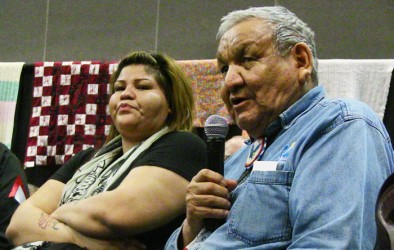Article Origin
Volume
Issue
Year
Alex Janvier is best known as a successful visual artist. When he speaks in public, art is usually the topic of the talk. However, on March 27, Janvier spoke not as an artist, but as a survivor of the residential school system to a panel of church leaders at the Truth and Reconciliation Commission’s final national event in Edmonton.
The Churches Listening Circle offered survivors the opportunity to share their stories with representatives who signed the Indian Residential Schools Settlement Agreement. The four church representatives present at the sharing circle were Archbishop Sylvain Lavoie OMI (Catholic), Reverend Gary Patterson (Moderator of the United Church of Canada), Les Young (Presbyterian), and Maude Parsons-Horst (Anglican).
Members of the public, including other clergy, filled the room to capacity as Janvier spoke, sitting around the circle with other survivors. “I think I’ll just ask for the country back. I teach my grandchildren and children to believe that they are the landlords,” says Janvier, who is from the Cold Lake First Nation and the father of six children.
Janvier discussed the abuse he suffered in residential school from a spiritual perspective. “We’re all going to go to hell you know - we’re Indians. Pretty scary stuff. When you’re a little kid you don’t know where hell was, but it sure the heck was not a good place to go from what I hear. That’s the training that we got and we became full of fear. Lots of fear. So we’re supposed to be going to school to learn things, but when you’re living in fear you don’t learn much.”
However, Janvier now has his own definition of hell because of residential school. “If you want to understand hell, just be an Indian, go to residential school, and you will live in hell for a number of years later. It is a complete wipe of what you are, what you contain, what you came to to this Earth for.”
This fear of hell extended into relationships with his family. “The rest of the program was denial of my language, culture, beliefs - even belief in the Great Spirit. They said our grandparents were evil and from the devil. That’s my grandmother and grandfather and I never had known them to say any words that were evil, and yet in that place we were made to believe that was what was going on back home.”
He also talked about physical abuse. “These teachers had these sticks that were about a yard long made of hickory so it doesn’t break off too easily. Our little hands burned when those sticks landed. That’s the history of residential schools and I am sure that all of us here in this room today we can go back and remember grandparents and parents and even children who have been there,” he said, acknowledging the intergenerational damage that residential schools have caused.
“We pass that on to our families. Even though they did not go to residential school, we pass it on to our children. This is a deadly existence.”
Like many artists, Janvier turned his pain into art. “I’m a famous artist today because of that school. I began to express the deep, hidden things inside that I could only express through art.”
Spiritually, Janvier has returned to traditional Native ways, in which he has found solace. “Finally, I found a way. I found a spiritual way, the Native spiritual way I began to follow and it has brought me back. It is amazing when you are coming back to what you really are.”
- 3028 views

